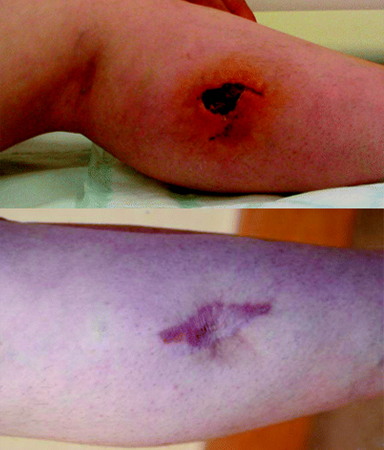Resumo
Definição
História e exame físico
Principais fatores diagnósticos
- presença de fatores de risco
- circunstâncias da mordida de animal
- descrição da ferida
- eritema
- induração
- flutuação
- drenagem purulenta
- adenopatia regional
- tecido necrosado
- sinais vitais instáveis
Fatores de risco
- idade <14 anos
- tutela de animal de estimação
- grupos de alto risco (para infecção por raiva)
- procedimentos médicos prévios (aumento do risco de infecção em caso de mordida)
- doenças subjacentes (aumento do risco de infecção em caso de mordida)
Investigações diagnósticas
Primeiras investigações a serem solicitadas
- culturas da ferida
- radiografia
Investigações a serem consideradas
- Hemograma completo
- hemoculturas
- angiografia
- fotografia
- swab do ácido desoxirribonucleico (DNA)
Algoritmo de tratamento
feridas não infectadas
mordida infeccionada sem complicação: sem alergia à penicilina
mordida infeccionada sem complicação: com alergia à penicilina
mordidas com complicação: sem alergia à penicilina
mordidas com complicação: com alergia à penicilina
Colaboradores
Autores
Oliver Spencer, MBBS, BSc, MRCS, FRCEM
Consultant, Emergency Medicine
Croydon University Hospital NHS Trust
London
UK
Declarações
OS declares that he has no competing interests.
Subhro Banerjee, MBBS, FRCEM
Consultant, Emergency Medicine
Croydon University Hospital
London
UK
Declarações
SB has no competing interests.
Agradecimentos
Dr Oliver Spencer and Dr Subhro Banerjee would like to gratefully acknowledge Dr A. Parfitt, Dr Randy Taplitz, and Dr Eric Chang, the previous contributors to this topic. AP and EC declare that they have no competing interests. RT has received funding from Pfizer to attend several antifungal symposia and funding from Schering-Plough to attend an antifungal Speaker's Bureau Workshop.
Revisores
Cynthia Christy, MD
Associate Chief of Pediatrics
General Pediatrics/Pediatric Infectious Diseases
University of Rochester
New York
NY
Declarações
CC declares that she has no competing interests.
Gregory Conners, MD, MPH, MBA, FAAP, FACEP
Interim Chair of Emergency Medicine
Professor of Emergency Medicine and Pediatrics
University of Rochester
New York
NY
Declarações
GC declares that he has no competing interests.
Jeffrey R. Suchard, MD, FACEP, FACMT
Professor of Clinical Emergency Medicine
Director of Medical Toxicology
Department of Emergency Medicine
University of California
Irvine Medical Center
Orange
CA
Declarações
JRS declares that he has no competing interests.
Créditos aos pareceristas
Os tópicos do BMJ Best Practice são constantemente atualizados, seguindo os desenvolvimentos das evidências e das diretrizes. Os pareceristas aqui listados revisaram o conteúdo pelo menos uma vez durante a história do tópico.
Declarações
As afiliações e declarações dos pareceristas referem--se ao momento da revisão.
Referências
Principais artigos
Rao AK, Briggs D, Moore SM, et al. Use of a modified preexposure prophylaxis vaccination schedule to prevent human rabies: recommendations of the Advisory Committee on Immunization Practices - United States, 2022. MMWR Morb Mortal Wkly Rep. 2022 May 6;71(18):619-27.Texto completo Resumo
Stevens DL, Bisno AL, Chambers HF, et al. Practice guidelines for the diagnosis and management of skin and soft tissue infections: 2014 update by the Infectious Diseases Society of America. Clin Infect Dis. 2014 Jul 15;59(2):e10-52.Texto completo Resumo
National Institute for Health and Care Excellence. Human and animal bites: antimicrobial prescribing. November 2020 [internet publication].Texto completo
Artigos de referência
Uma lista completa das fontes referenciadas neste tópico está disponível para os usuários com acesso total ao BMJ Best Practice.

Diagnósticos diferenciais
- Lesão dos tecidos moles
Mais Diagnósticos diferenciaisDiretrizes
- Recommended immunization schedule for adults aged 19 years or older
- Recommended immunization schedule for children and adolescents 18 years or younger
Mais DiretrizesConectar-se ou assinar para acessar todo o BMJ Best Practice
O uso deste conteúdo está sujeito ao nosso aviso legal